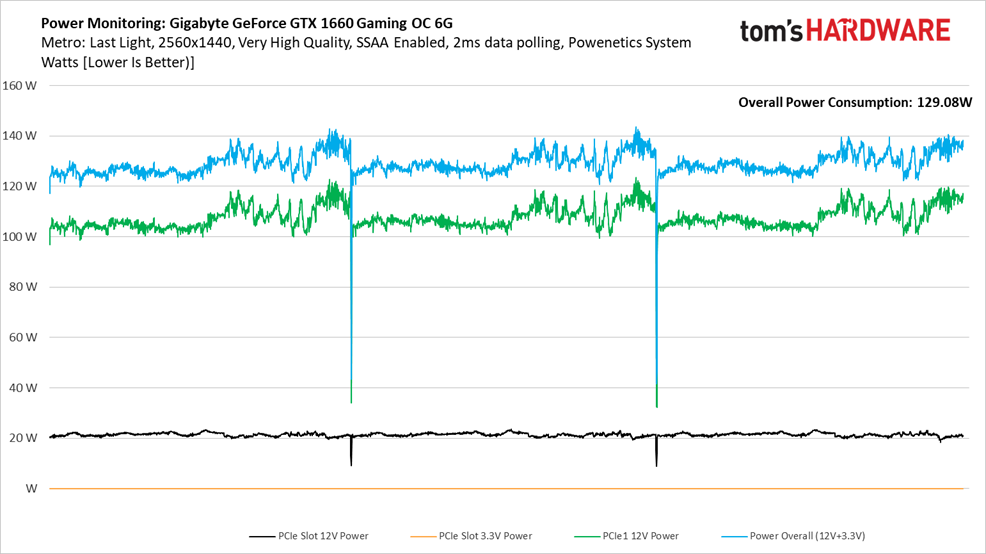Gigabyte GeForce GTX 1660 Gaming OC 6G Review: A Mainstream Turing Hotrod
Why you can trust Tom's Hardware
Power Consumption
Slowly but surely, we’re spinning up multiple Tom’s Hardware labs with Cybenetics’ Powenetics hardware/software solution for accurately measuring power consumption.
Powenetics, In Depth
For a closer look at our U.S. lab’s power consumption measurement platform, check out Powenetics: A Better Way To Measure Power Draw for CPUs, GPUs & Storage.
In brief, Powenetics utilizes Tinkerforge Master Bricks, to which Voltage/Current bricklets are attached. The bricklets are installed between the load and power supply, and they monitor consumption through each of the modified PSU’s auxiliary power connectors and through the PCIe slot by way of a PCIe riser. Custom software logs the readings, allowing us to dial in a sampling rate, pull that data into Excel, and very accurately chart everything from average power across a benchmark run to instantaneous spikes.
The software is set up to log the power consumption of graphics cards, storage devices, and CPUs. However, we’re only using the bricklets relevant to graphics card testing. Gigabyte's GeForce GTX 1660 Gaming OC 6G gets all of its power from the PCIe slot and one eight-pin PCIe connector.
Idle
Gigabyte’s GeForce GTX 1660 Gaming OC 6G uses a couple more watts at idle than the company’s 1660 OC 6G. Both cards employ a passive fan mode, so the difference must be attributable to the higher-end model’s RGB lighting.
Gaming: Metro: Last Light
The 1660 Gaming OC 6G also uses more power through our Metro benchmark sequence, though only by a few watts. Despite a significantly different fan configuration (3x 80mm versus 2x 90mm), both boards behave similarly.
Get Tom's Hardware's best news and in-depth reviews, straight to your inbox.
Charting power consumption across our three-run test illustrates quite a bit more variance in the eight-pin auxiliary cable’s dips and peaks compared to GeForce GTX 1660 OC 6G. This behavior is repeatable, too—we see the same results each time the Metro benchmark plays through.
But overlaying Gigabyte’s 1660 Gaming OC 6G over other cards in its class assures us that power consumption isn’t something to worry about. The line charts all overlap quite a bit.
Gigabyte keeps current draw over the PCIe slot under 2A, well below the PCI-SIG’s ceiling.
FurMark
The 1660 Gaming OC 6G’s power consumption in FurMark is 13W higher than Gigabyte’s 1660 OC 6G, most of which is delivered by the eight-pin auxiliary connector.
There’s no room for performance to vary in FurMark, so the wavy line chart we saw under Metro: Last Light is gone, replaced by much more consistent power consumption through more than 15 minutes of recording.
Now, the 1660 Gaming OC 6G sits quite a ways above the comparison cards, including Gigabyte’s own GeForce GTX 1660 OC 6G. It acts more like a GeForce GTX 1070 through our test (though it’s nowhere near as fast).
Current draw from the PCIe slot exceeds 2A but remains well below its rated limit.
MORE: Best Graphics Cards
MORE: Desktop GPU Performance Hierarchy Table
MORE: All Graphics Content
Current page: Power Consumption
Prev Page Gaming at 2560 x 1440 Next Page Temperatures, Fan Speeds and Clock Rates









